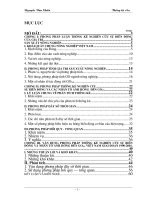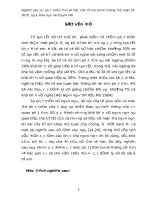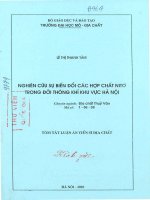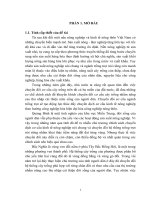Nghiên cứu sự chuyển đổi về ngữ dụng học trong cách nói từ chối của sinh viên việt nam
Bạn đang xem bản rút gọn của tài liệu. Xem và tải ngay bản đầy đủ của tài liệu tại đây (488.69 KB, 92 trang )
THAI NGUYEN UNIVERSITY
SCHOOL OF FOREIGN LANGUAGES
TRAN THI THUY AN
AN INVESTIGATION ON PRAGMATIC TRANSFER IN
VIETNAMESE EFL REFUSALS
(Nghiên cứu sự chuyển đổi về ngữ dụng học
trong cách nói từ chối của sinh viên Việt Nam)
M.A. THESIS
Field: English Linguistics
Code: 8220201
THAI NGUYEN – 2018
THAI NGUYEN UNIVERSITY
SCHOOL OF FOREIGN LANGUAGES
TRAN THI THUY AN
AN INVESTIGATION ON PRAGMATIC TRANSFER IN
VIETNAMESE EFL REFUSALS
(Nghiên cứu sự chuyển đổi về ngữ dụng học
trong cách nói từ chối của sinh viên Việt Nam)
M.A. THESIS
(APPLICATION ORIENTATION)
Field: English Linguistics
Code: 8220201
Supervisor: Dr. Duong Duc Minh
THAI NGUYEN – 2018
ACKNOWLEDGEMENTS
I would like to express my deep thanks to people who have assisted me when
I carried out the research.
I would like to express my sincere appreciation to my supervisor, Dr. Duong
Duc Minh for his encouragement and guidance throughout the research who gave
me his precious comments, expert advice and most of his kind encouragement
during my doing research.
Also, I would like to acknowledge my grattude to all of the lecturers and the
staff of the Department of Post-Graduate Studies at School of Foreign Languages,
Thai Nguyen University for their valuable lectures and supports.
I am greatly indebted to my colleagues and students at Thai Nguyen College
of Educaton, Thai Nguyen School of Foreign Languages, University of Wollongong,
Australia for their enthusiasm, helpfulness, care and patence towards my data
collection which grant great contributons for my thesis.
Finally, I would like to express my special thanks to my parents, my husband
and other members in my family for their love, care, support and encouragement
so that I could accomplish my study.
i
STATEMENT OF AUTHORSHIP
I hereby declare the thesis enttled
An Investigaton on Pragmatc Transfer in Vietnamese EFL Refusals
is the result of my own research for the Degree of Master of Arts at the
School of Foreign Languages - Thai Nguyen University and this thesis is in total
fulfillment of the requirements for the Degree Master of Arts. This thesis has not
been submitted for any degree and any other university or instituton.
Signed
Date
ii
ABSTRACT
This study is an attempt to investgate similarites and diferences in the
speech acts of refusals among natve Vietnamese speakers (NVs), Australian natve
speakers of English (NEs), and Vietnamese learners of English (VEs). The Written
DCT (Discourse Completon Test) was used for data collecton. Research subjects
included
90 people in three groups: 30 natve Vietnamese speakers, 30 Vietnamese English
learners, and 30 Australian natve English speakers. The performance of three
groups were compared to find out the diferences in semantc formulae of refusals
made by Vietnamese, Vietnamese English learners and natve English speakers, the
characteristics of pragmatic transfer in EFL learners. The responses were coded
according to the classificaton of refusal strategies as outlined by Beebe et al.,
(1990). The findings reveal that pragmatc transfer exists in choice and content of
semantic formulae. Natve speakers liked to use more direct refusal strategies and
positve feelings than Vietnamese speakers and the pragmatc transfer occurred in
Vietnamese EFL learners.
3
LIST OF ABBREVIATIONS
B.A:
Bachelor of Arts
DCT:
Discourse Completon Task EFL:
English as a Foreign Language ESL:
English as a Second Language L1:
First Language
L2:
Second Language NE:
Natve English NNSs:
Non-
natve Speakers NSs:
Natve Speakers
NV:
Natve Vietnamese
VE:
Vietnamese EFL learners
4
LIST OF TABLES
Table
Page
Table 3.1: Classificaton of DCT ..........................................................................19
Table 3.2
The semantic formulas used in the analysis of data (Beebe et
al., 1990 and modified by Phuong, 2014) ...........................................20
Table 4.1: Refusals to a request of higher status person ......................................23
Table 4.2: Examples of semantc formula ............................................................24
Table 4.3: Refusals to a request of lower status person........................................25
Table 4.4: Examples of semantc formula ............................................................25
Table 4.5: Refusals to an invitaton of higher status person.................................26
Table 4.6: Examples of semantc formula ............................................................26
Table 4.7: Refusals to an invitaton of lower status person..................................27
Table 4.8: Examples of semantc formula ............................................................27
Table 4.9: Refusals to an ofer of a higher status person .....................................28
Table 4.10: Examples of semantc formula ............................................................28
Table 4.11: Refusals to an ofer of a lower status person.......................................29
Table 4.12: Examples of semantc formula ............................................................29
Table 4.13: Refusals to a suggeston of a higher status person ..............................30
Table 4.14: Examples of semantc formula ............................................................30
Table 4.15: Refusals to a suggeston of a lower status person ...............................31
Table 4.16: Examples of semantc formula ............................................................31
5
TABLE OF CONTENTS
Page
ACKNOWLEDGEMENTS
................................................................................
i
STATEMENT OF AUTHORSHIP ................................................................... ii
ABSTRACT
......................................................................................................iii
LIST OF ABBREVIATIONS ........................................................................... iv LIST
OF TABLES ............................................................................................. v TABLE
OF CONTENTS .................................................................................. vi CHAPTER
I: INTRODUCTION ................................................................... 1
1.1. Ratonale for the study.......................................................................... 1
1.2. Aims of the study.................................................................................. 2
1.3. Research Questions............................................................................... 2
1.4. Significance of the study ...................................................................... 2
1.5. Scope of the study................................................................................. 2
1.6. Outline of the study .............................................................................. 3
CHAPTER II: LITERATURE REVIEW...................................................... 4
2.1. Pragmatc Transfer ............................................................................... 4
2.2 Factors afectng pragmatc transfer ...................................................... 5
2.3 Speech Acts ........................................................................................... 6
2.4 Refusal as a Speech Act ........................................................................ 8
2.5 Classificaton of Speech Acts ................................................................ 9
2.6 Studies on the Speech Act of Refusals ................................................ 12
CHAPTER III: METHODOLOGY ............................................................. 17
3.1. Research approach .............................................................................. 17
3.2. Subjects of the study........................................................................... 17
3.3. Instrument ........................................................................................... 17
3.4. Data collecton procedure and analysis .............................................. 19
3.4.1 Data collecton procedure ................................................................. 20
3.4.2 Data Analysis.................................................................................... 20
CHAPTER IV: FINDINGS AND DISCUSSION........................................ 22
4.1 Refusals to requests ............................................................................. 23
6
4.1.1 Refusal to a request of salary payment (higher) ...............................
23
4.1.2 Refusal to a request of staying late (lower) ...................................... 25
4.2 Refusals to invitations ......................................................................... 26
4.2.1 Refusal to an invitaton to a restaurant (higher) ............................... 26
4.2.2 Refusal to an invitaton to a boss party (lower)................................ 27
4.3 Refusals to ofers ................................................................................. 28
4.3.1 Refusal to an ofer to pay for a vase (higher) ................................... 28
4.3.2. Refusal to an offer to an executve promoton (lower) .................. 29
4.4 Refusals to suggestions........................................................................ 30
4.4.1 Refusal to a suggeston to have more conversation in Foreign
Language (higher)........................................................................... 30
4.4.2. Refusal to a suggeston to write a reminder (lower) ...................... 31
4.5. Choice of semantic formulae used in refusals of Vietnamese EFL
learners ....................................................................................................... 32
4.5.1 ‘Explanaton’ .................................................................................... 32
4.5.2. “Gratitude’ ....................................................................................... 33
4.5.3. Positve feeling & Regret ................................................................ 33
4.5.4. Direct ‘No’....................................................................................... 34
4.5.5 Social Status ..................................................................................... 35
4.5.6 Social Distance ................................................................................. 35
CHAPTER V: CONCLUSIONS................................................................... 37
5.1 Semantc formulae for the speech act of refusals used by native
speakers of Vietnamese, Native English and Vietnamese EFL learners
............. 37
5.2 Pragmatc transfer in the semantc formulae used in refusals of
Vietnamese EFL learners................................................................... 38
5.3 Implicatons ......................................................................................... 38
5.4 Limitations ........................................................................................... 39
5.5 Recommendations for Future Studies ................................................. 39
REFERENCES ............................................................................................... 41
APPENDIX ..................................................................................................... 45
vii
CHAPTER I: INTRODUCTION
1.1. Ratonale for the study
Language is the carrier of culture and culture the substance of language: The
two cannot exist separately (Romaine, 2000). To succeed in communicating with
others, one must be aware of the culture behind the language used in
communicaton (Tanck, 2004). When speaking a foreign language, the issue of
culture becomes critical. English as Foreign language (EFL) learners, especially those
with languages diferent and distant from English psychologically, culturally,
phonologically, and syntactically, may struggle when attempting to communicate in
English. Non-profcient language learners are not only jeopardized by
their
imperfect language knowledge but obstructed by their inadequate knowledge of
culture.
To compensate for their lack of knowledge, EFL learners may fall back on
their own linguistc cultural reservoir, translating utterances from their mother
tongue and applying their own cultural rules when communicatng in English (AlEryani,
2007; Lauper, 1997). This might lead to pragmatc errors that could result in
misunderstanding and embarrassment or pragma-linguistc failure (Riley, 1989;
Thomas, 1983; Umale, 2011).
This is especially important nowadays as “cross-cultural communicaton is
becoming an integral part of life, with globalizaton and rapid advances in new
technology” (Umale, 2011, p. 19). In additon, employment opportunites in the
local and global market increasingly demand good language proficiency and
communicatve ability. Therefore, teaching pragmatc rules in a way that they
would involve communicaton strategies and speech acts will give students the
English knowledge and communicatve competence that will secure good job
placements after graduaton.
1
The phenomenon of pragmatc transfer and their motvating factors have
been investgated in several speech acts in diferent languages, such as English,
Hebrew, Spanish, French, German, Danish, Arabic and Portuguese (Byon, 2004).
Several cross-cultural studies proved that pragmatic transfer is evident in L2
speech
2
performance. As for Asian languages, except for Japanese, the number of ILP
studies is limited. To this date, there has been no single attempt to study pragmatc
transfer in Vietnamese speech acts of refusal. To this date, there has been no
single attempt to study pragmatc transfer in Thai Nguyen university students’
speech acts of refusal.
1.2. Aims of the study
The present study aims to investigate the semantic formulae for the speech
act of refusal by native speakers of Vietnamese, native English and Vietnamese EFL
learners then explore whether the pragmatic transfer exist in the semantic formulae
of Vietnamese English language learners. Taking the refusal speech act as a case in
point, it sought to discover how Vietnamese EFL university students used English
when refusing requests, invitations, ofers, and suggestions presented to them in a
set of scenarios. The study examines whether the responses appropriate
pragmatically and accurate linguistically and the factors that could have influence
them.
1.3. Research Questons
1. What are the semantc formulae for the speech act of refusals used by
natve speakers of Vietnamese, natve English and Vietnamese EFL learners?
2. To what extent does pragmatc transfer exist in the semantic formulae used
in refusals of Vietnamese EFL learners?
1.4. Significance of the study
Many cross-cultural refusal studies have a methodological problem, in that
they are focused mainly on oral interactions, even though data were often
collected via written surveys. In additon, no attenton, as far as I can find, has
been given to refusals within mountainous students who are studying EFL.
Therefore, it is important to investgate refusal patterns when learning English of
these students, especially in Thai Nguyen University.
1.5. Scope of the study
3
This study will only focus on investgatng the pragmatc transfer used in
refusals of students Thai Nguyen University. The native Vietnamese students will
come from College of Educaton, natve English students will come from University
4
of Wollongong, Australia and non-natve EFL students will come from School of
Foreign Languages – Thai Nguyen University.
1.6. Outline of the study
This paper’s contents were arranged in an order which reveals informaton
from theoretical to empirical.
Chapter I: INTRODUCTION, gives an overview of the study. More
partcularly, it includes statement of the problem, the main reasons leading to this
research, intentonal aims, objectives as well as brief descripton of scope and
significance, methods, and design of the inquiry.
Chapter II: LITERATURE REVIEW, clarifies theoretcal background and
related preceding studies relevant for the research. Both positve impacts and
disadvantages will be exposed in this section.
Chapter III: RESEARCH METHODOLOGY, focuses on elicitng research
questons, research methods, data collecton procedure and data analysis.
Chapter IV: FINDINGS AND DISCUSSION, helps to examine the semantc
formulae for the speech act of refusals used by native speakers of Vietnamese,
native English and Vietnamese EFL learners then find out the pragmatc transfer
which exist in the semantc formulae used in refusals of Vietnamese EFL learners.
Chapter V: CONCLUSION, briefly summaries the main points of the paper,
provides essental findings, displays existing limitatons together with implications
and gives suggestions for further studies.
Finally, REFERENCES and APPENDICES are also listed suficiently at the end
of the research.
5
CHAPTER II: LITERATURE REVIEW
2.1. Pragmatc Transfer
Defining pragmatc transfer is not any easier because of researchers’
disagreement about how to define the scope of pragmatcs. According to Olshtain
and Cohen (1989),
pragmatc transfer refer to
L2 learners’ strategy of
incorporatng natve-language-based elements in L2 producton. The proposed
definitons reflect the problem. According to Wolfson, “the use of rules of speaking
from one's own natve speech community when interactng with members of the
host community or simply when speaking or writng in a second language is known
as sociolinguistic or pragmatc transfer” (1989, p. 141). Since then, pragmatc
transfer in EFL has received considerable attention and becomes an important
source of cross-cultural communicaton breakdown (e.g. Beebe, Takahashi, & UlissWeltz, 1990). A good example of pragmalinguistc transfer is provided by Takahashi
and DuFon’s (1989) study which examined nine Japanese English ESL learners’ use
of indirectness in two request situatons. They found that the L2 learners at
beginning proficiency level were either too direct or too indirect in their choice of
indirectness in one of the situatons. Byon (2004) also identfied and described
socio-pragmatic features of Americans learning Korean as a foreign language in the
Korean communicatve act of requests. The semantc formulae usage patterns of
the learners of Korean as a foreign language were consistent with those of the
American ENSs, indicatve of an L1 transfer efect.
Regarding pragmatc transferability, Takahashi (1993, 1996) maintains that if
L1 strategy is perceived to be frequently used and assumed to be appropriate
enough, this strategy would more likely be transferred to the L2 context. Her
second transferability criteria, that is equivalence of strategies in L1 and L2, is
perceived the equivalent of the L1 and L2 pair of a request strategy in terms
of contextual appropriateness. Based on the two above criteria, she proposed a
pragmatc transferability scale, which posits that strategies rated high for
6
contextual appropriateness and viewed as contextual equivalents are more
transferable, whereas
7
those that are rated low for appropriateness and considered contextually diferent
are less transferable.
2.2 Factors affectng pragmatc transfer
Occurrences of pragmatc transfer may be influenced by various factors
including L2 learners’ percepton of language distance between their L1 and L2 (e.g.
Takahashi, 1996), learning context (e.g. Takahashi & Beebe, 1987), instructonal
effect (e.g. Bardovi-Harlig, 2001; Kasper, 1982), L2 proficiency (e.g. Olshtain &
Cohen, 1989; Takahashi & Beebe, 1987), and length of tme in the L2 community
(e.g., Félix-Bradsefer, 2004). The study by Robinson (1992) suggests that L2 learners
may be more prone to transfer their pragmatc L1 knowledge when they hold a
universalist view. More specifically, these studies demonstrated that L2 learners
may not transfer L1 pragmatc features to the L2 if they perceive them as language
specific.
Recently, Phan (2001) listed twelve socio-cultural factors that, in his point of
view, may afect the choice of directness and indirectness in communicaton:
1. Age: the old tend to be more indirect than the young.
2. Sex: females prefer indirect expression.
3. Residence: the rural population tends to use more indirectness than the
urban.
4. Mood: while angry, people tend to use more indirectness.
5. Occupation: those who study social sciences tend to use more
indirectness than those who study natural sciences.
6. Personality: the extroverted tend to use more directness than the
introverted.
7. Topic: while referring to a sensitve topic, a taboo, people usually prefer
indirectness.
8. Place: when at home, people tend to use more directness than when they
are elsewhere.
9. Communicatve environment/setting: when in an informal climate,
people tend to express themselves in a direct way.
8
10. Social distance: those who have closer relatons tend to talk in a more
direct way.
11. Time pressure: when in a hurry, people are likely to use direct
expressions.
9
12. Positon: when in a superior positon, people tend to use more
directness to their inferiors. These factors help to determine the strategies used
when speakers perform the act of refusing
The present study was intended to address the issue of pragmatc
transferability by examining the transferability of English refusal strategies
when Vietnamese learners of English realize English refusals in corresponding
L2 contexts.
2.3 Speech Acts
The concept of speech acts was first developed by Austn (1962), and
defined as a set of utterances by which people perform a specific functon such as
apologizing, complaining, requestng, refusing, complimentng, or thanking. Austn
(1962) identfied three diferent features of speech acts: (i) locutionary, (ii)
illocutionary, and (iii) perlocutionary acts. Locutonary act refers to a literal
meaning of an utterance; illocutionary act refers to an intended meaning of an
utterance; and perlocutonary act is the actual efect by saying something. For
example, one performs a locutonary act when s/he describes the thermal
conditon of a room by saying it is hot here. In this descripton, the thermal
conditon of the room is given by the word hot and the room itself is referred to by
the word here. However, if one says the same thing expecting some actions to be
taken such as opening a window or turning on an air-conditoning unit to lower
the room temperature, then s/he is performing an illocutionary act. The opening
of the window or turning on the air- conditioning then is the effect of the
utterance, which is a perlocutionary act.
Vaezi (2011) also defined speech act as a functonal unit in communicaton.
It is an act that speakers implement when making utterances. All languages have
almost unique ways of performing speech acts. Although speech acts are univ
ersals, the method used in performing speech acts is dissimilar in diferent
cultures (Vaezi,
2011).
10
To put it more succinctly, a speech act is an acton performed by an
utterance
(Belza, 2008; Brut, 2006). The utterance usually carries an attitude, and this attitude
11
corresponds to the speech act being performed (Bach, 2007). The listener’s
understanding of the atttude leads to understanding the speech
act.
Since the intended meaning of speech acts or illocutonary acts is a vital
component of speech acts, Austin (1962) presented a classificaton of illocutonary
acts based on the function of the verbs used. However, because of “the
ungrounded nature, unclarity, and overlap of these classes” several researchers
have proposed different taxonomies of illocutonary acts (Horn & Ward, 2004, p.
64). For example, Searle (1976) proposed five classificatons for illocutionary acts,
which are defined in the following manner.
• Representatives (or Assertves) are speech acts in which a speaker
commits to the truth of the expressed statements (e.g., describing something).
• Commissives are speech acts in which a speaker commits some future
actons
(e.g.,
promising,
swearing).
guaranteeing,
and
• Directives are speech acts in which a speaker requests the hearer to
perform a partcular acton (e.g., commanding, requesting).
• Expressives are speech acts in which a speaker expresses his/her feelings
(e.g., thanking, apologizing, welcoming).
• Declarations are speech acts that change the reality in accord with the
propositon of the declaraton (e.g., nominatng, resigning).
Speech acts can also be realized directly or indirectly, but they are
frequently carried out indirectly in our everyday lives to soften the force of the
act (LoCastro,
2012). When a speech act is performed indirectly and thus the linguistc form
does not explicitly represent the speaker’s actual intenton, an addressee needs
to infer the intended meaning of the speaker’s utterance. Understanding of the
speaker’s actual intenton requires the addressee to consider the meaning of the
utterance in a partcular context. Furthermore, in order to appropriately respond,
12
the addressee also needs to know the appropriate practces of speech acts in a
given speech community.
Examples of speech acts include requestng, ofering, apologizing,
complimentng, congratulatng, sympathizing, and refusing, all of which are
13
language-based actons. Because the present study focuses on refusals as
produced by natve speakers of Vietnamese, Vietnamese EFL speakers and native
speakers, the following secton reviews the literature on this partcular speech act.
2.4 Refusal as a Speech Act
Refusal is a “face-threatening act that tends to disrupt harmony in
relatonships” (Umale, 2011, p. 18). Due to its sensitvity, a refusal can be perceived
differently between speaker and listener. It is a negatve response to another
speech act issued in the form of a request, invitaton, or suggestion (Abdul Sattar,
Che Lah,
& Suleiman, 2011). Due to the nature, refusals can afect people’s relatonships
adversely if perceived as impolite or uncaring. According to Umale (2011), refusals
may damage the positive face of the speaker and threaten the negative face of the
listener. Therefore, the author contnues to “mitgate threats to face” caused by
refusals, speakers can use politeness strategies (p. 19).
Among recent studies that have been carried out on the refusal speech act,
Beebe, Takahashi and Uliss-Weltz (1990) found that Japanese refuse differently
according to the status of interlocutors, while Americans are more affected by the
degree of familiarity or the social distance between interlocutors. Japanese display
a different frequency of semantc formulae between higher and lower status
requesters, while Americans do not. These studies are cross-cultural – in other
words, comparatve-cultural – rather than intercultural.
Gass & Houck (1999) also defined refusals as speech acts that occur as
negatve responses to other acts such as requests, invitatons, ofers, and
suggestions. While some researchers view refusals as Commissive speech acts
(e.g., Félix- Brasdefer, 2004; García, 2007), refusals may not always fall into this
category as they are not always rejections and sometimes involve negotaton in
which the partcipants do not even know what the final outcome will be. In
addition, Farnia and Wu (2012) investgated the refusals to invitaton by use of a
written discourse completon test and an immediate structured interview aimed to
14
examine their perception concerning their cogniton and language of thought in
the process of refusing. The findings showed that both groups used similar types of
refusal strategies, but they difered in
15
the frequency of the refusals. In additon, the most frequent refusal strategies
were found to be statements of regret, excuses, reasons and explanaton and
expression of negatve ability and willingness.
2.5 Classificaton of Speech Acts
Austn (1975) establishes five categories of speech act based on broad
classes of illocutonary force. They are as follows. Verdictives are acts in which a
verdict or appraisal is given, usually by someone in a positon of power to give that
appraisal. Exercitives involve the exercise “of powers, rights, or influence.” Austn’s
examples of exercitves include “appointing…urging… warning” Commissives
commit the speaker to an acton or intenton; they include promises as well as
mental commitments like taking one side of an argument (Austn, 1975).
The last two of Austin’s categories are broader than the first three, and
defined in a vague way that Austn acknowledges as problematic. Behabitves have
to do with social behavior, including “apologizing, congratulating, commending,
condoling, cursing, and challenging.” Austin acknowledges the broad scope of this
category, but moves on to describing the even vaguer expositives, which he defines
as “making plain how our uterances ft into the course of an argument or
conversation, how we are using words, or, in general, are expository”. Examples are
‘I reply’, ‘I argue’, ‘I concede’, ‘I illustrate’, ‘I assume’, ‘I postulate’” (Austin, 1975).
Searle (1976) challenges Austn’s taxonomy on the basis of the categories
that Austn himself admits are problematc. Searle establishes a set of features that
vary across speech acts and creates a taxonomy of speech acts based on variaton
in these features. Searle lists twelve of these features, which he calls “dimensions
of variation”, but the following three are most significant for his purposes. First is
illocutonary point, the purpose of a speech act. Searle illustrates illocutonary
point by comparing requests with commands: while they are diferent speech acts
with different amounts of force behind them, they share the purpose of
getting the addressee to do something. Second is directon of fit: whether the
words comprising the speech act are intended to match the world, as in assertons
16









